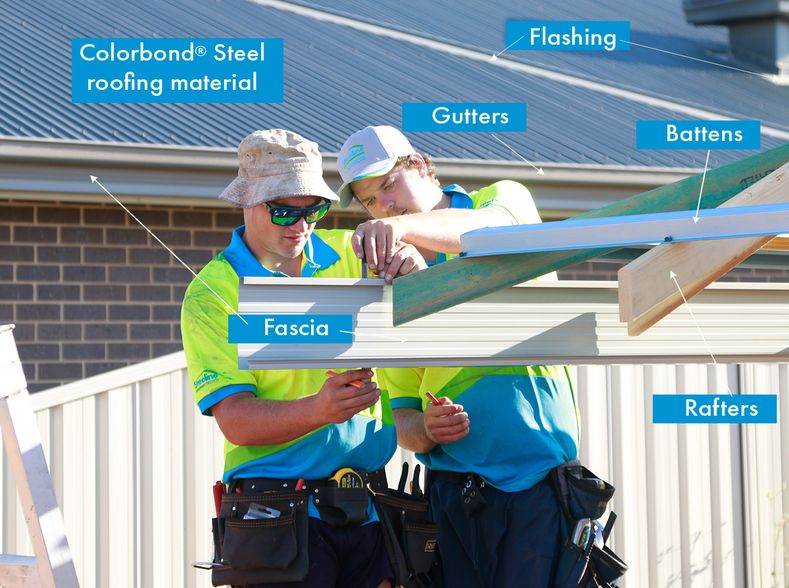Whether you're a homeowner, a DIY enthusiast, or a professional in the construction industry, understanding the various terms associated with roofs is essential. A well-maintained and properly constructed roof not only enhances the visual appeal of your home but also provides protection from the many harsh elements that are common in Australia. In this glossary article, we'll explore the world of roof terminology, explaining the key components that go together to construct a roof.
Rafters:
On a pitched roof, the rafters are the sloped beams that form the support framework of a roof's structure. They run from the top ridgeline down to the eaves, providing support for your roofing materials. The triangular shape of rafters connected together with the bottom beam (which holds your internal ceiling) is also known as a truss. Rafters are typically made from wood or metal and are spaced apart according to the design and load-bearing requirements of the roof.
Battens:
Battens are narrow strips of wood or metal that run horizontally along the roof's surface, perpendicular to the rafters. They serve as a surface for securing roofing materials and are especially useful for metal roofing or tiles that need a mounting or securing location.
Roofing Materials:
Roofing materials come in a wide range of options, each with its own unique characteristics, advantages and considerations. Some common roofing materials include:
- Concrete Tiles: A traditional roofing material that has been used for many years and is the most common roofing material used in Australia. They are known for their longevity and aesthetic appeal.
- Metal Roofing: a roofing material that is gaining popularity, metal roofs are durable, fire-resistant, and energy-efficient. They come in various metals like steel, zinc and sometimes aluminium offering both contemporary and traditional looks. Steeline FNW is a specialist manufacturer in Colorbond® metal roofing offering a great alternative to concrete tiles.
- Asphalt Shingles: are not a common form of roofing material in Australia. They are more prevalent in North America where a roof needs to support snow for a number of months. They are popular due to their affordability and ease of installation.
- Wood Shingles or Shakes: These materials offer a rustic charm and are often chosen for historical or cottage-style homes. Proper maintenance is essential to prevent rot and decay.
- Synthetic Roofing: Materials like synthetic slate, rubber, or composite shingles mimic the appearance of traditional materials while offering modern benefits like durability and lower maintenance.
Flashing:
Flashing refers to the metal strips or pieces installed around roof joints, valleys, chimneys, skylights, and other areas that are prone to water leaks. The primary purpose of flashing is to direct rainwater away from vulnerable areas and prevent water infiltration through the roof. Flashing can be made from materials like aluminum, copper, or galvanised steel, and is crucial for maintaining a watertight seal in areas where it can penetrate into your home. Steeline FNW is a specialist manufacturer of flashing using quality Australian Colorbond steel or Zincalume and can custom fold the flashing to suit the specific requirements of your roof.
Fascia:
Fascia is the horizontal board that runs along the bottom edge of the roof, typically located behind the gutters. The fascia serves mainly a visual purpose, providing a clean surface that hides all of the ‘ugly’ internal elements of your roof such as the rafters and create a finished look to your roof line. It also provides a mounting surface for clips to hold the gutters and helps protect the eaves from weather damage. Traditionally, a fascia has been made from wood, however more and more houses are switching towards a metal fascia, given its long-life and stylish look that does not need painting or maintenance. Steeline FNW can supply metal fascia products in over 30 different colours.
Gutters:
Gutters are the channels installed along the edge of the roof to collect and direct rainwater away from the building. Properly functioning gutters are essential for preventing water damage to the structure and landscaping and for minimising erosion around the foundation. Gutters are usually made from materials like aluminum, steel, PVC plastic, or copper. They are accompanied by downpipes, which carry the collected water to either a rainwater tank or to the storm water drains. Steeline FNW can manufacture and supply your gutters made from quality Colorbond® steel or Zincalume® as well as supply rainwater tanks.
We hope we’ve demystified the terminology associated with a roof design. Whether you're planning a new roof installation, making repairs, or simply seeking a deeper understanding of your home's protective covering, this knowledge equips you with the vocabulary to navigate discussions with roofing contractors. Remember that the roof of your home is a very big part of overall value and curb appeal of your property so be sure to invest in a quality finish.


